40 Clematis Varieties to Grow in Your Garden for a Pretty Pop of Purple
Find the best purple clematis varieties for bold garden color
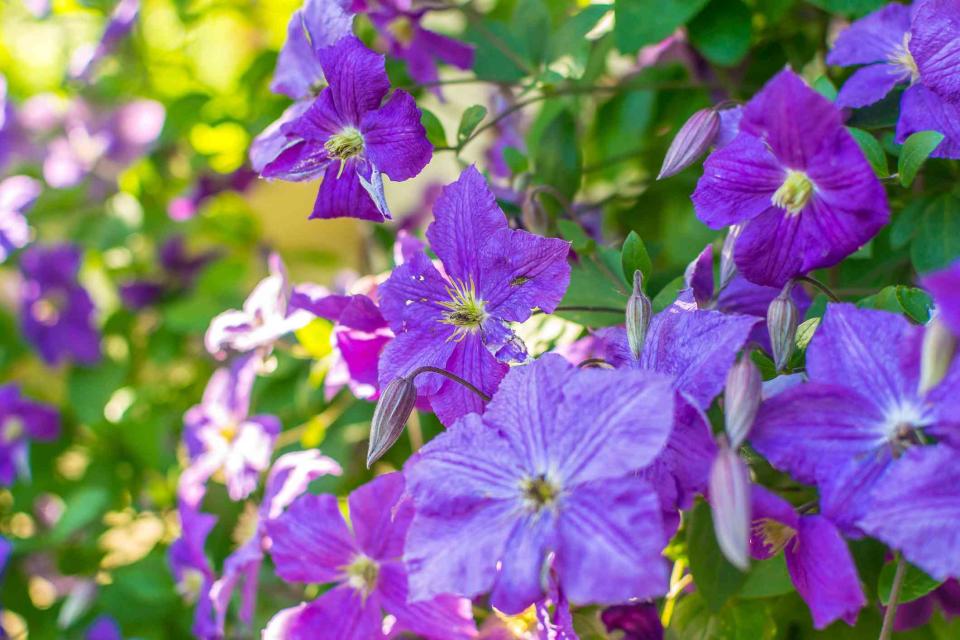
andreymuravin / Getty Images
If you’re looking for colorful ornamentals to add vertical interest to gardens and yards, clematis plants are one of the best options. Globally, there are over 300 clematis species, plus countless more hybrid clematis varieties. Most clematis are perennial, deciduous vines, but there are also evergreen clematis vines, shrubby clematis, and shorter clematis that grow as herbaceous perennials.
Clematis flowers range in size from petite, bell-shaped blooms to large flowers in breathtaking shades of pink, white, yellow, and purple. Find 40 of the most popular and adaptable purple clematis for gardens, trellises, groundcovers, and containers in the list below.
Want more gardening tips? Sign up for our free gardening newsletter for our best-growing tips, troubleshooting hacks, and more!
Alpine
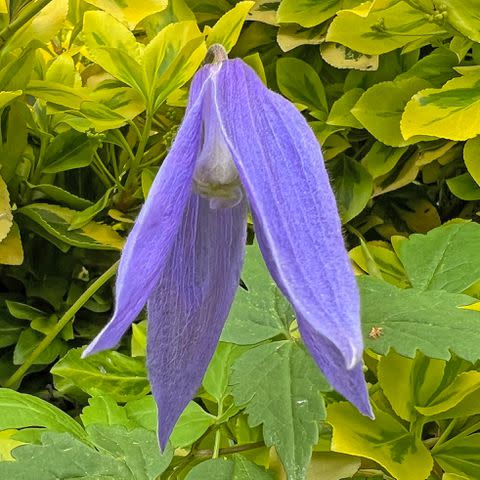
Tim Green / Flickr / CC BY 2.0
Alpine clematis are early and prolific bloomers with small, bell-shaped flowers that come in a range of purple hues. These plants rarely need pruning, although they can be trimmed on occasion for a tidier look.
Plant Type: Perennial, deciduous vine
Size: 6 to 10 ft. long
Light: Partial to full shade
Growing Zone: 4 to 9
H. F. Young
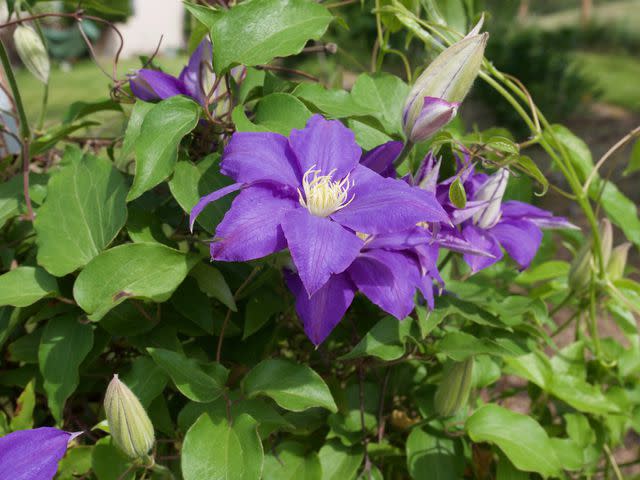
F. D. Richards / Flickr / CC BY-SA 2.0
With massive, six to nine inch wide, pale purple flowers, H.F. Young is sure to stand out in any garden. These deciduous climbers look stately on trellises and fences, and they produce flowers in late spring and fall.
Plant Type: Perennial, deciduous vine
Size: 8 to 10 ft. long
Light: Full sun to partial shade
Growing Zone: 4 to 9
Hairy
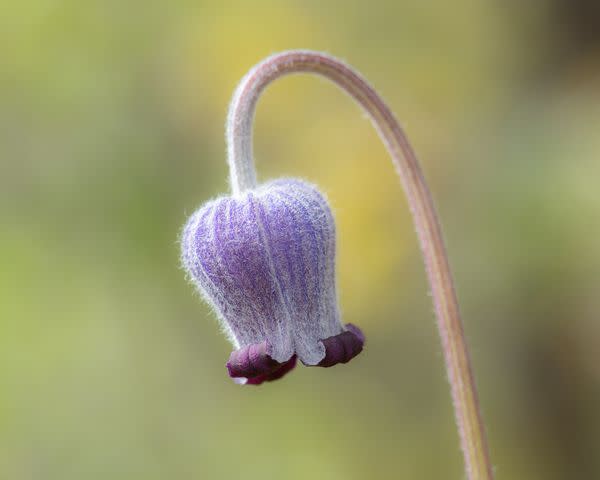
Marshal Hedin / Flickr / CC BY-SA 2.0
Also known as sugarbowls or vase flowers, hairy clematis is a North American native that grows wild throughout the western United States. These undemanding and adaptable plants are covered in fine, silvery hairs and their purple, bell-shaped flowers are magnets for bees, butterflies, and hummingbirds.
Plant Type: Herbaceous perennial
Size: Up to 2 ft. tall
Light: Full sun to partial shade
Growing Zone: 3 to 7
Nelly Moser
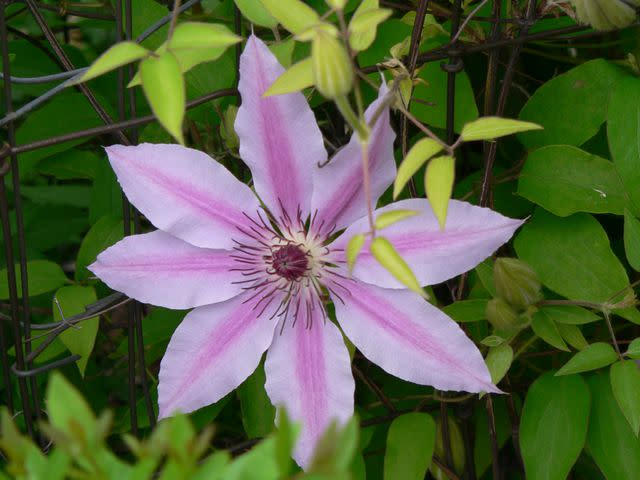
F. D. Richards / Flickr / CC BY-SA 2.0
Flashy Nelly Moser has large, bi-colored blooms with white petals accented by bold, pinkish-purple stripes. However, this plant isn’t as sun tolerant as some other clematis varieties and it should be grown in part shade to prevent flower bleaching.
Plant Type: Perennial, deciduous vine
Size: 8 to 10 ft. long
Light: Partial shade
Growing Zone: 4 to 9
Hagley Hybrid
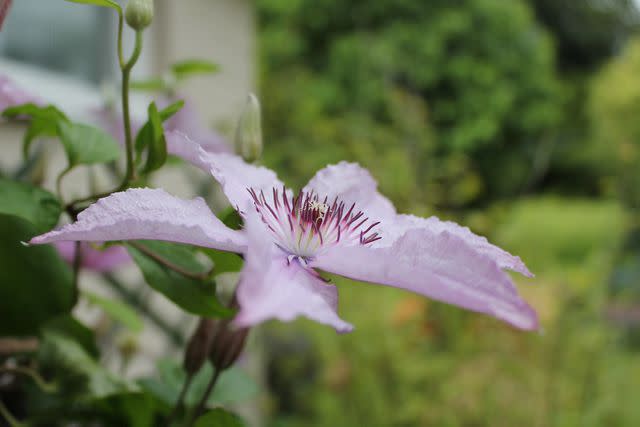
Tim Sheerman-Chase / Flickr / CC BY 2.0
If you want to enjoy clematis flowers late in the season, try Hagley Hybrid. These plants produce elegant, lavender-colored flowers on new growth and they typically bloom from midsummer to fall.
Plant Type: Perennial, deciduous vine
Size: 6 to 8 ft. long
Light: Full sun to partial shade
Growing Zone: 4 to 9
Anemone
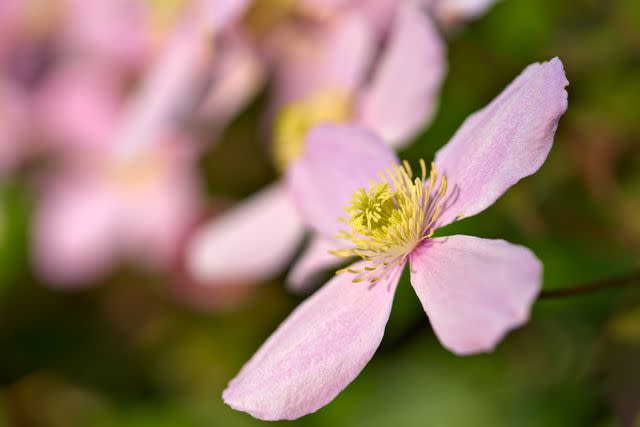
Peter Stenzel / Flickr / CC BY-ND 2.0
Anemone clematis is named for its dainty, pinkish-purple flowers, which closely resembles the blooms of anemone plants. Fast-growing and adaptable, anemone clematis can be trained to grow on arbors, planted as a low maintenance groundcover, or cultivated along garden borders for an easy splash of color.
Plant Type: Perennial, deciduous vine
Size: 20 to 25 ft. long
Light: Full sun to partial shade
Growing Zone: 6 to 9
Madame Julia Correvon
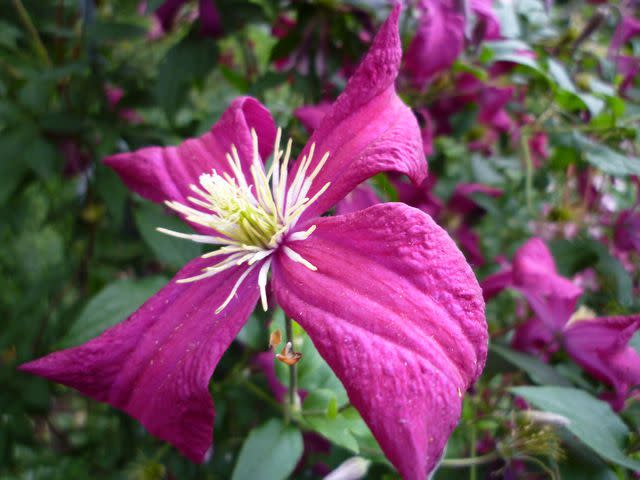
Corinna Ascher / Flickr / CC BY-SA 2.0
A long season bloomer, Madame Julia Correvon produces purplish-red, star-shaped flowers that liven up garden beds from early summer to fall. This clematis can hold its own in a large garden, but it will also thrive in a roomy container if you’re gardening in a small space.
Plant Type: Perennial, deciduous vine
Size: 9 to 12 ft. long
Light: Full sun to partial shade
Growing Zone: 4 to 11
Doctor Ruppel
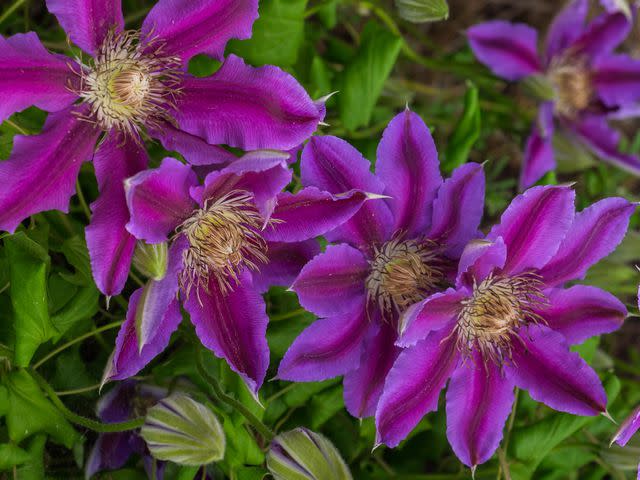
F. D. Richards / Flickr / CC BY-SA 2.0
Doctor Ruppel is another profuse bloomer that flowers in late spring to early summer, and produces a second wave of brightly colored flowers in early autumn. Bi-colored blooms are ornamented with bright, purplish-pink stripes and they have lightly ruffled petals for extra pizzazz.
Plant Type: Perennial, deciduous vine
Size: 8 to 10 ft. long
Light: Full sun to partial shade
Growing Zone: 4 to 11
Huvi
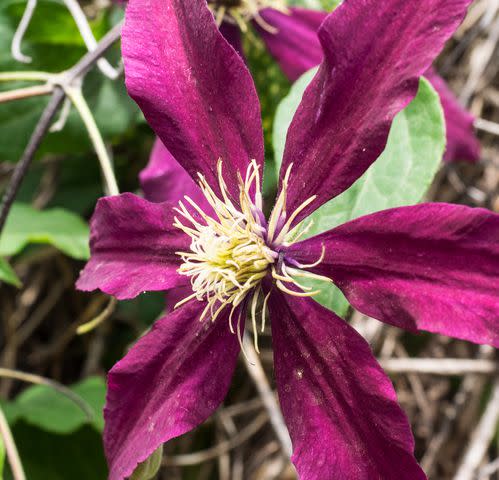
F. D. Richards / Flickr / CC BY-SA 2.0
Sprawling clematis plants can quickly overwhelm small gardens, but Huvi clematis is a compact grower that thrives in small spaces and pots. These plants are cold hardy, generally disease resistant, and their reddish-purple flowers look stunning when paired with other colorful ornamentals, like Japanese maples and daylilies.
Plant Type: Perennial, deciduous vine
Size: 5 to 6 ft. long
Light: Full sun to partial shade
Growing Zone: 3 to 9
Elsa Spath
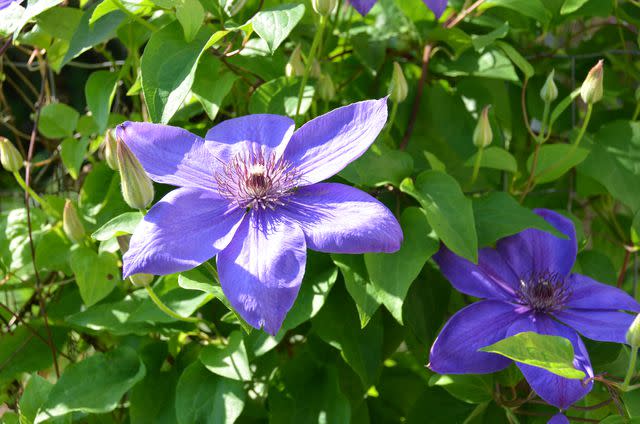
F. D. Richards / Flickr / CC BY-SA 2.0
Elsa Spath clematis were first grown in Berlin, Germany in the late 19th century, but these hardy plants can be found throughout the world today. Blooming first in early summer and again later in the season, Elsa Spath flowers are a vivid purple when they first unfurl, but they fade to pink as they age.
Plant Type: Perennial, deciduous vine
Size: 6 to 10 ft. long
Light: Full sun to partial shade
Growing Zone: 4 to 9
Prince Charles
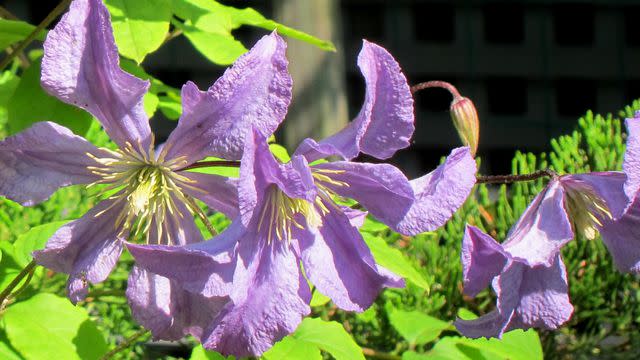
Cultivar413 / Flickr / CC BY 2.0
Purple is the color of royalty and the pale lavender flowers of Prince Charles clematis definitely bring an elegant feel to garden spaces. These compact plants bloom throughout summer, they’re resistant to clematis wilt, and they can be grown in pots or larger gardens.
Plant Type: Perennial, deciduous vine
Size: 6 to 8 ft. long
Light: Full sun to partial shade
Growing Zone: 4 to 9
Pale Leatherflower
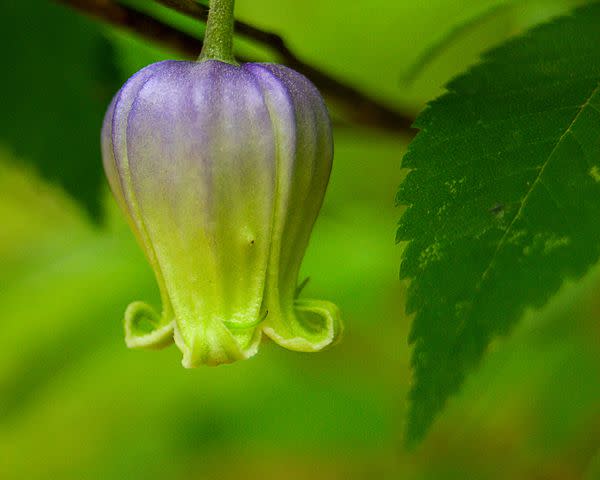
Visualized Perception / Flickr / CC BY 2.0
Like hairy clematis, pale leatherflower is a North American native plant that brings subtle beauty to garden beds with its purple, bell-shaped flowers. These plants can thrive in a range of soils, including rocky gardens, but they grow best in consistently moist earth.
Plant Type: Perennial, deciduous vine
Size: 6 to 16 ft. long
Light: Full sun to partial shade
Growing Zone: 5 to 9
Ramona
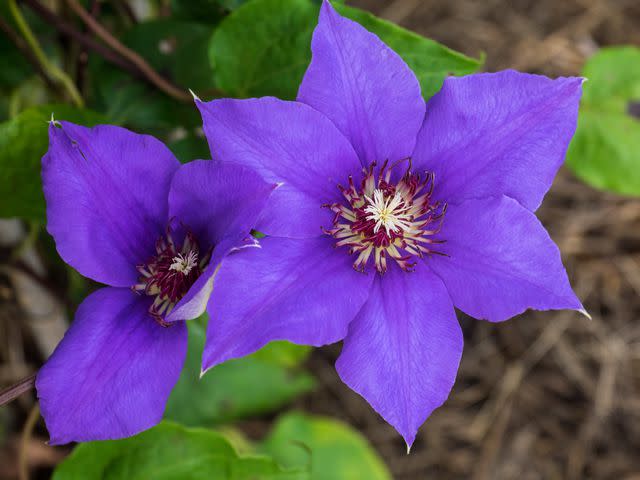
F. D. Richards / Flickr / CC BY-SA 2.0
Late-blooming Ramona clematis can’t help but impress with its lavender flowers and bright red anthers, which add interesting contrast to the plant’s look. This climber blooms on both old and new wood; however, it flowers more prolifically if you deadhead spent blooms when they begin to fade.
Plant Type: Perennial, deciduous vine
Size: 8 to 12 ft. long
Light: Full sun to partial shade
Growing Zone: 4 to 11
Sprinkles
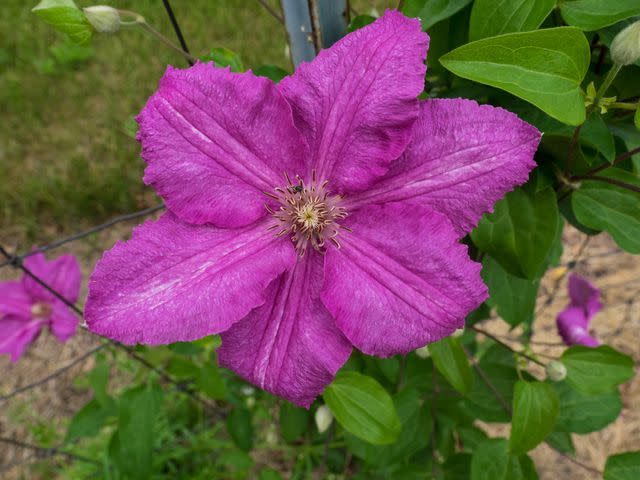
F. D. Richards / Flickr / CC BY-SA 2.0
Sprinkles clematis have a playful name and a playful look to match with pinkish-purple flowers accented with contrasting white stripes. A repeat summertime bloomer, Sprinkles adds lots of color to flower beds, but these flamboyant flowers can also be used in cut flower arrangements.
Plant Type: Perennial, deciduous vine
Size: 8 to 12 ft. long
Light: Full sun to partial shade
Growing Zone: 4 to 11
Sapphire Indigo
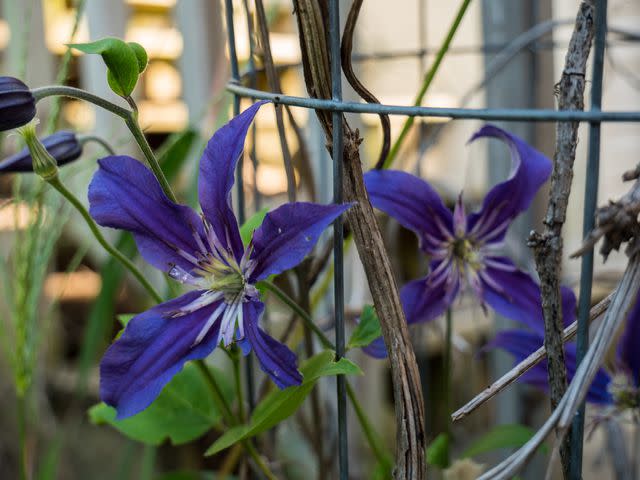
F. D. Richards / Flickr / CC BY-SA 2.0
Compact Sapphire Indigo clematis can be grown in containers, cultivated as short, bushy vines, or planted as groundcovers beneath taller perennials. Deep purple flowers bloom nearly continuously from June to September; however, the flowers shift to a rich blue color as they age.
Plant Type: Perennial, deciduous vine
Size: 3 to 4 ft. long
Light: Full sun to partial shade
Growing Zone: 4 to 9
Crispa
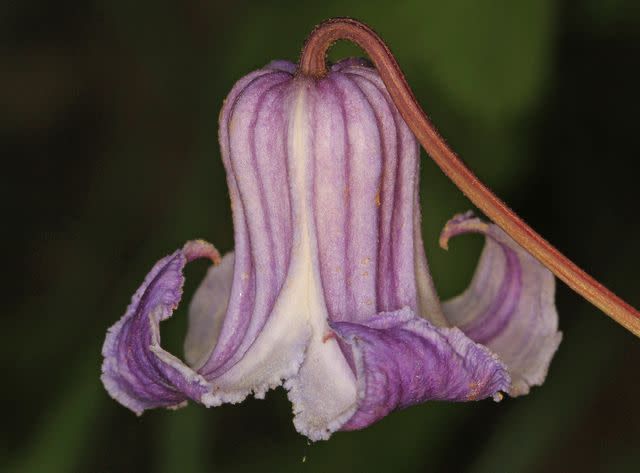
Judy Gallagher / Flickr / CC BY 2.0
Also known as curlflower or swamp leatherflower, Crispa clematis is native to parts of the United States and it naturally grows in areas with moist soil. These plants flower earlier than most other clematis and they typically produce their small, bell-shaped blooms in mid-spring and again in early fall.
Plant Type: Perennial, deciduous vine
Size: 6 to 10 ft. long
Light: Full sun to partial shade
Growing Zone: 6 to 9
Ernest Markham
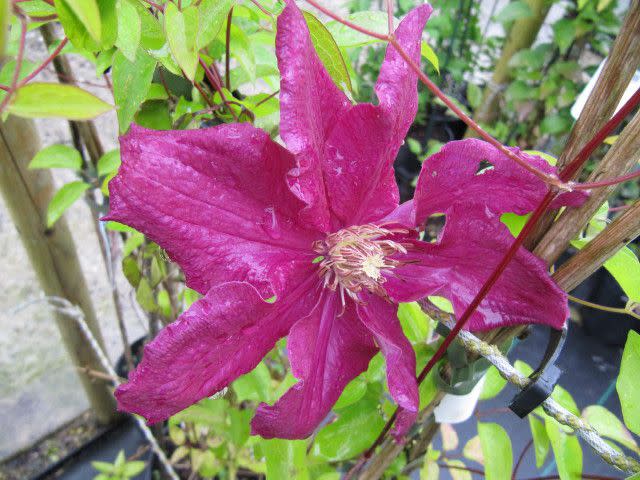
Leonora (Ellie) Enking / Flickr / CC BY-SA 2.0
Fast-growing Ernest Markham clematis were first introduced in the 1920s and they’ve been impressing gardeners ever since. These deciduous climbers bloom abundantly from mid-summer to early fall and their pinkish-purple flowers look attractive on trellises, arbors, free-standing obelisks, and garden walls too.
Plant Type: Perennial, deciduous vine
Size: 10 to 12 ft. long
Light: Full sun to partial shade
Growing Zone: 4 to 11
Happy Birthday
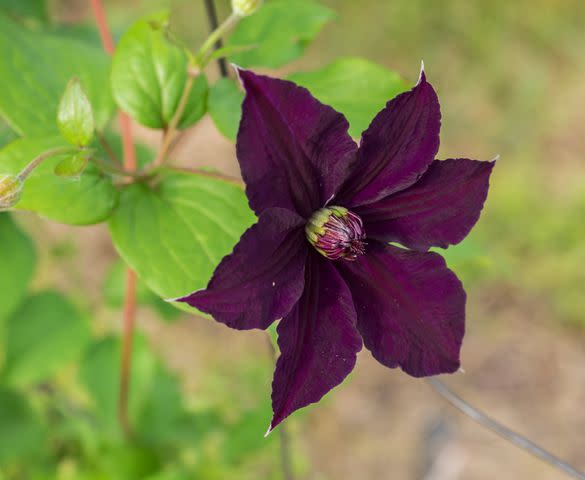
F. D. Richards / Flickr / CC BY-SA 2.0
Also known as Zohapbi, you don’t need to be celebrating your birthday to enjoy Happy Birthday clematis. Flowering on both new and old wood, Happy Birthday plants produce deep purple flowers with reddish streaking from May through September—and they’re small enough to grow in pots or flower beds.
Plant Type: Perennial, deciduous vine
Size: 8 to 10 ft. long
Light: Full sun
Growing Zone: 5 to 9
Cezanne
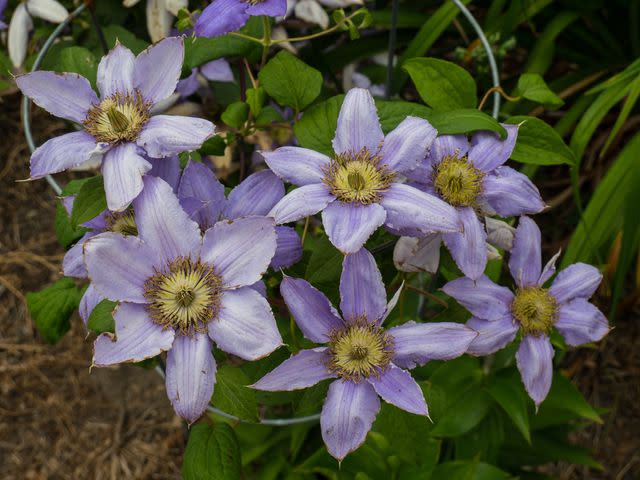
F. D. Richards / Flickr / CC BY-SA 2.0
Pretty as a picture, Cezanne clematis yield pale purple flowers that measure about six inches across and are ornamented by contrasting white stamens. Another prolific bloomer, Cezanne can potentially flower from spring through fall and its compact growth habit is ideal for small garden spaces.
Plant Type: Perennial, deciduous vine
Size: 3 to 4 ft. long
Light: Full sun
Growing Zone: 4 to 9
Alita
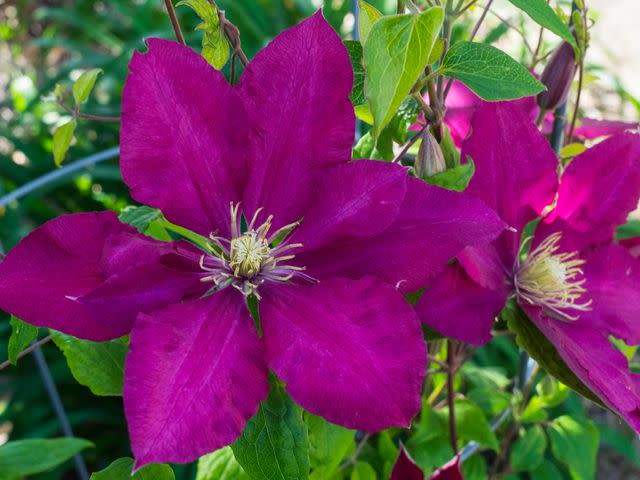
F. D. Richards / Flickr / CC BY-SA 2.0
Alita clematis flower on new growth, which makes these plants quite cold hardy and resilient. Blooming reliably throughout the summer months, Alita yields reddish-purple flowers with creamy-white stamens, which are highly attractive to pollinators, yet resistant to deer and rabbits.
Plant Type: Perennial, deciduous vine
Size: 4 to 6 ft. long
Light: Full sun to partial shade
Growing Zone: 4 to 9
The President
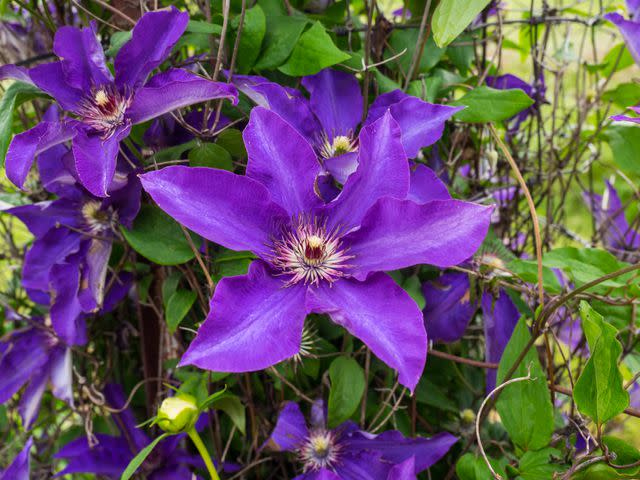
F. D. Richards / Flickr / CC BY-SA 2.0
Since its release in 1876, The President clematis has been one of the most popular and widely planted clematis varieties in home gardens. With its deep purple flowers and reblooming nature, it’s no surprise that The President won the Royal Horticultural Society’s Award of Garden Merrit.
Plant Type: Perennial, deciduous vine
Size: 4 to 6 ft. long
Light: Full sun to partial shade
Growing Zone: 6 to 10
Carnaby
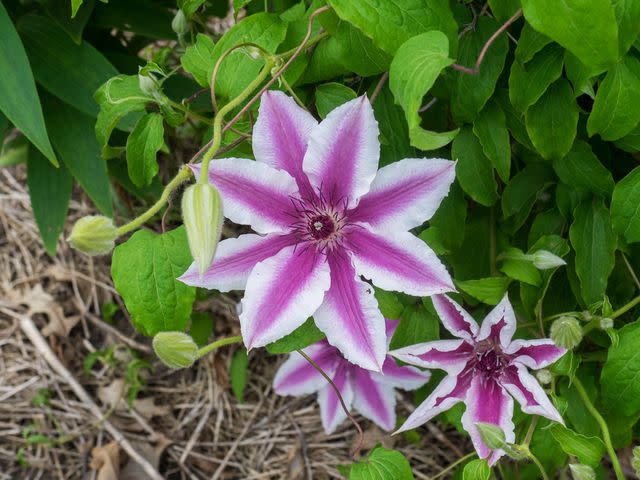
F. D. Richards / Flickr / CC BY-SA 2.0
Carnaby clematis is the perfect size for limited spaces and it keeps gardens colorful with bright, raspberry-hued blooms. In late spring, Carnaby produces massive, eight inch wide flowers that often fade to white as they age; however, you can enjoy Carnaby’s blooms again when the plant produces its second flush of flowers in late summer.
Plant Type: Perennial, deciduous vine
Size: 6 to 8 ft. long
Light: Full sun to partial shade
Growing Zone: 4 to 9
Yamato
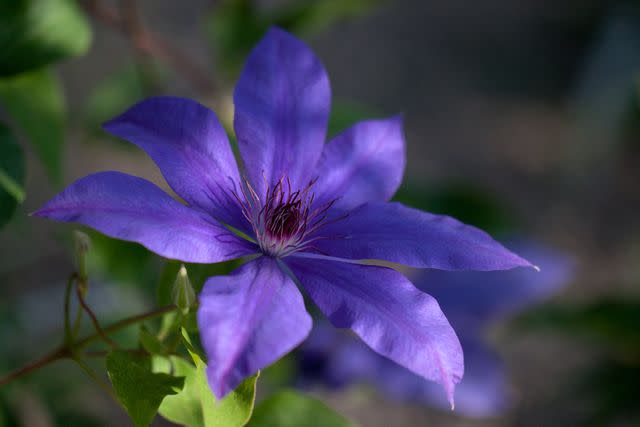
Yoko Nekonomania / Flickr / CC BY 2.0
Usher summer in with the bright purplish-blue flowers of Yamato clematis, which blooms from late spring to the beginning of summer. This clematis is a bit harder to find than plants like The President and Anemone, but it’s well worth the hunt if you want to experiment with a more unusual clematis.
Plant Type: Perennial, deciduous vine
Size: 6 to 8 ft. long
Light: Full sun to partial shade
Growing Zone: 4 to 8
Crystal Fountain
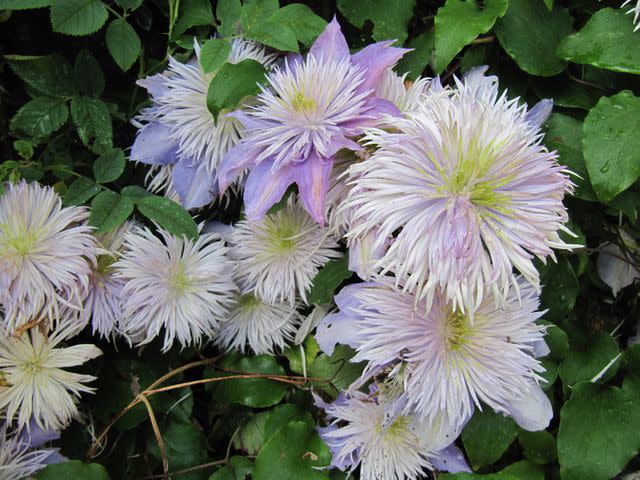
Leonora (Ellie) Enking / Flickr / CC BY-SA 2.0
Many of the most common clematis have single blooms, but Crystal Fountain produces colorful semi-double flowers with a truly one-of-a-kind look. Plants bloom throughout summer with pinkish-purple petals providing the perfect backdrop to this plant’s silvery “fountain” of stamens.
Plant Type: Perennial, deciduous vine
Size: 4 to 7 ft. long
Light: Full sun to partial shade
Growing Zone: 4 to 9
Samaritan Jo
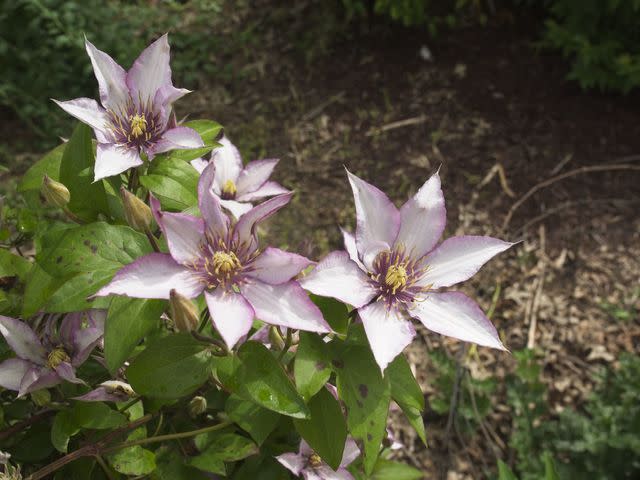
F. D. Richards / Flickr / CC BY-SA 2.0
A perfect complement for shady garden corners, Samaritan Jo has a dreamy look with pale, star-shaped flowers edged in a deep purple. Dark, leathery leaves contrast nicely against the plant’s ethereal blooms and Samaritan Jo’s compact growth habit means you can grow it in gardens or pots.
Plant Type: Perennial, deciduous vine
Size: 4 to 5 ft. long
Light: Full sun to partial shade
Growing Zone: 4 to 9
Piilu
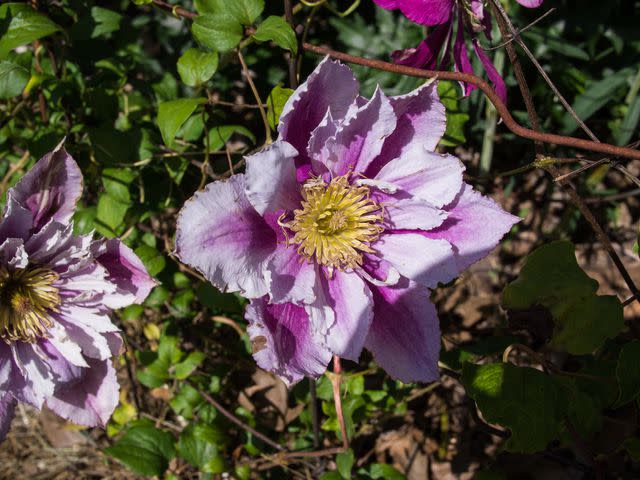
F. D. Richards / Flickr / CC BY-SA 2.0
Gardeners who love the look of peonies need to give Piilu clematis a try. These plants produce showy, pinkish-purple flowers that can be either single or double-bloomed with ruffled petals. Piilu also flowers on both old and new wood during a bloom season that stretches from spring to fall.
Plant Type: Perennial, deciduous vine
Size: 4 to 5 ft. long
Light: Full sun to partial shade
Growing Zone: 4 to 9
Jackmanii
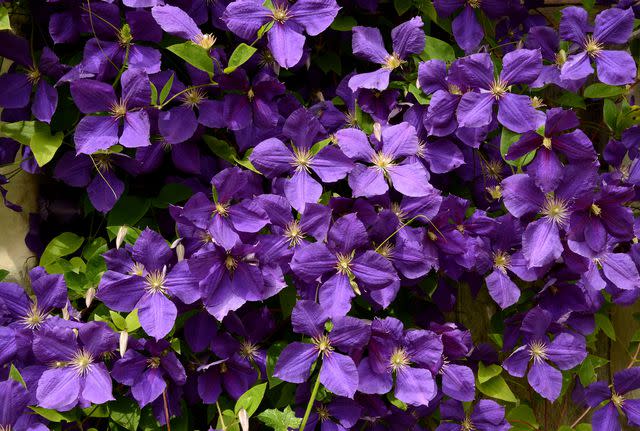
Anne Arnould / Flickr / CC BY-SA 2.0
A classic choice for sunny trellises, arbors, and gardens walls, Jackmanii has been around since the 1800s and it’s still one of the most popular clematis varieties today. Large, seven inch wide purple flowers often have just four petals, although some Jackmanii blooms will occasionally produce up to six petals.
Plant Type: Perennial, deciduous vine
Size: 7 to 10 ft. long
Light: Full sun
Growing Zone: 4 to 8
Franziska Maria
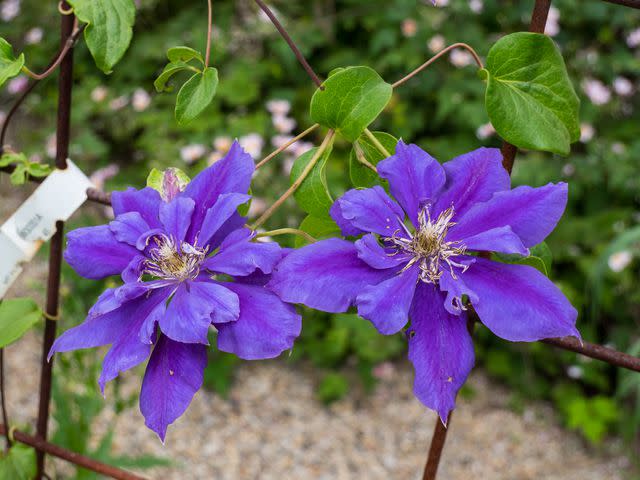
F. D. Richards / Flickr / CC BY-SA 2.0
Franziska Maria may be small, but it makes a big impact in containers, flower beds, and as a blooming groundcover. Flowering from June to September, Franziska Maria’s dahlia-like, purple flowers are always double bloomed with creamy white centers.
Plant Type: Perennial, deciduous vine
Size: 5 to 7 ft. long
Light: Full sun to partial shade
Growing Zone: 4 to 10
Vyvyan Pennell
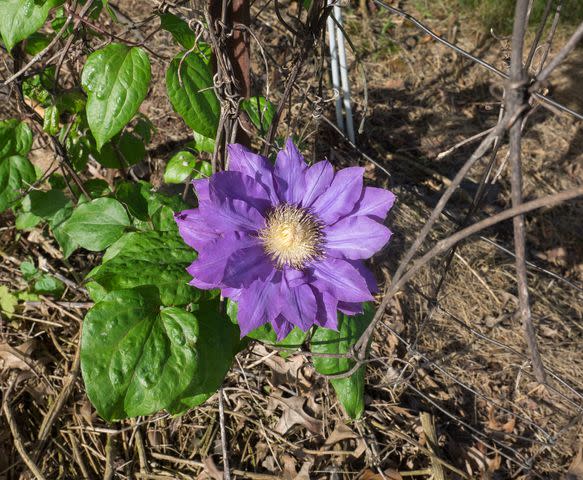
F. D. Richards / Flickr / CC BY-SA 2.0
Double-bloomed Vyvyan Pennell flowers on old wood and blooms earlier in the season than many other clematis types. Deep purple flowers measure about eight inches across and feature rosy-lavender highlights, which are easy to spot from a distance.
Plant Type: Perennial, deciduous vine
Size: 6 to 9 ft. long
Light: Full sun to partial shade
Growing Zone: 4 to 9
Rouge Cardinal
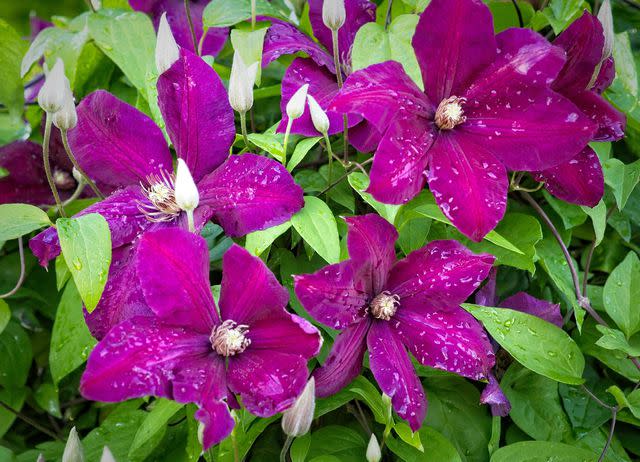
F. D. Richards / Flickr / CC BY-SA 2.0
Rouge Cardinal has flaming crimson petals that are so deeply saturated with color they appear almost purple in a certain light. Large blooms first appear in midsummer, but they can continue to delight garden-goers into early fall.
Plant Type: Perennial, deciduous vine
Size: 6 to 12 ft. long
Light: Full sun to partial shade
Growing Zone: 4 to 11
Vasevine
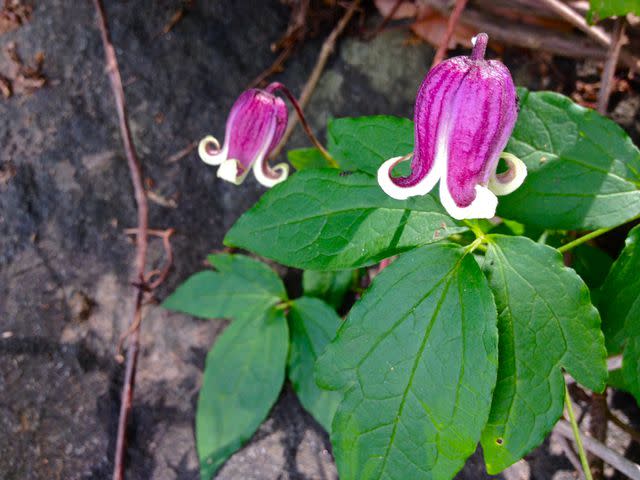
Fritz Flohr Reynolds / Flickr / CC BY-SA 2.0
Also known as Clematis viorna, North American native vasevines have a wilder look than more cultivated clematis and their urn-shaped flowers bring a magical feel to gardens. Pollinators love these plants, and butterflies and moths often use them as host plants for their caterpillars.
Plant Type: Perennial, deciduous vine
Size: 8 to 12 ft. long
Light: Partial shade
Growing Zone: 4 to 9
Maria Therese
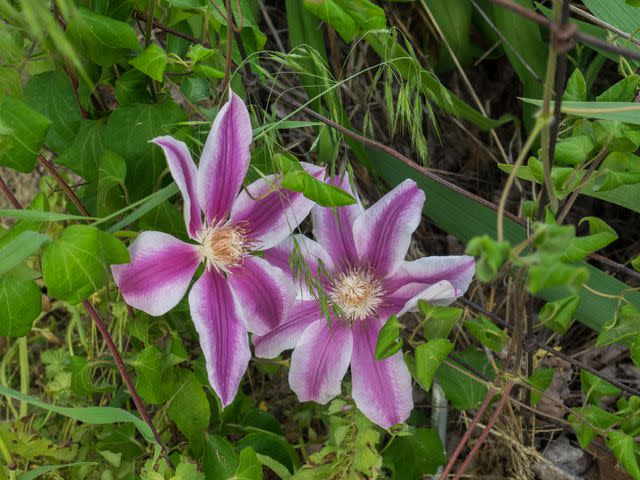
F. D. Richards / Flickr / CC BY-SA 2.0
Maria Therese is another striped clematis with raspberry-hued streaks running the length of its bright white petals. Like most other clematis, Maria Therese will grow best in a spot that provides some light shade to its roots and plenty of sun to its leaves and flowers.
Plant Type: Perennial, deciduous vine
Size: 4 to 6 ft. long
Light: Full sun to partial shade
Growing Zone: 4 to 9
Fireworks
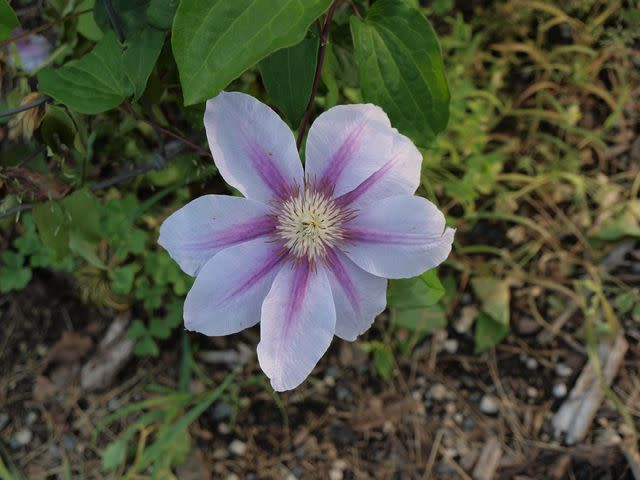
F. D. Richards / Flickr / CC BY-SA 2.0
Early blooming Fireworks clematis creates an explosion of color on trellises and arbors when its bi-colored flowers appear in late spring and again in late summer. Large, eight inch wide flowers have a brilliant look with purple petals, magenta barring, and cream-toned centers.
Plant Type: Perennial, deciduous vine
Size: 8 to 12 ft. long
Light: Full sun to partial shade
Growing Zone: 4 to 8
Solitary
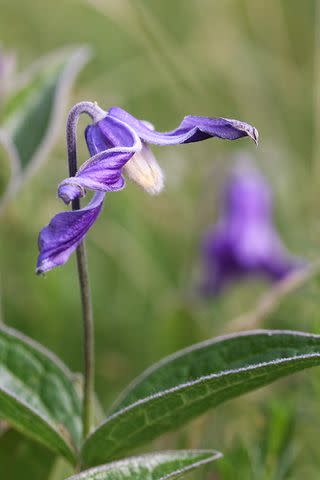
Charlie Jackson / Flickr / CC BY 2.0
Also known as bush clematis, solitary virgin's bower clematis is a bushy perennial that doesn’t climb, although it still has plenty of charm. Graceful, nodding flowers last from May to July and they draw in pollinators of all sorts, as well as songbirds.
Plant Type: Herbaceous perennial
Size: 1 to 3 ft. tall
Light: Full sun to partial shade
Growing Zone: 3 to 7
Westerplatte
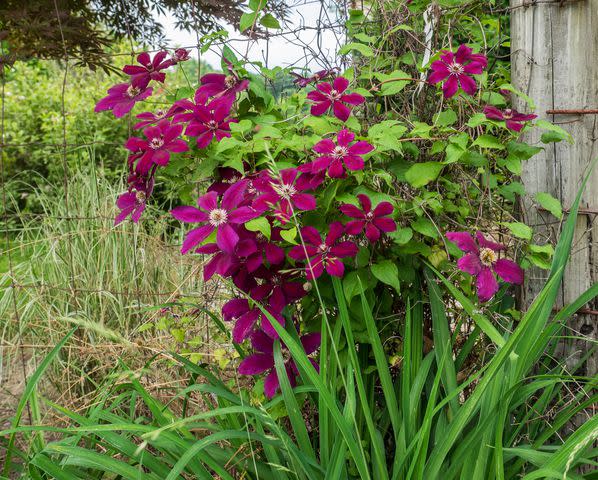
F. D. Richards / Flickr / CC BY-SA 2.0
The dark, purplish-red flowers of Westerplatte clematis have a bewitching look as they ramble over obelisks, arbors, small trees, and garden walls. The delight of spring gardens, Westerplatte typically flowers from spring to early summer, but plants may rebloom later in the season.
Plant Type: Perennial, deciduous vine
Size: 6 to 10 ft. long
Light: Full sun to partial shade
Growing Zone: 4 to 9
Gipsy Queen
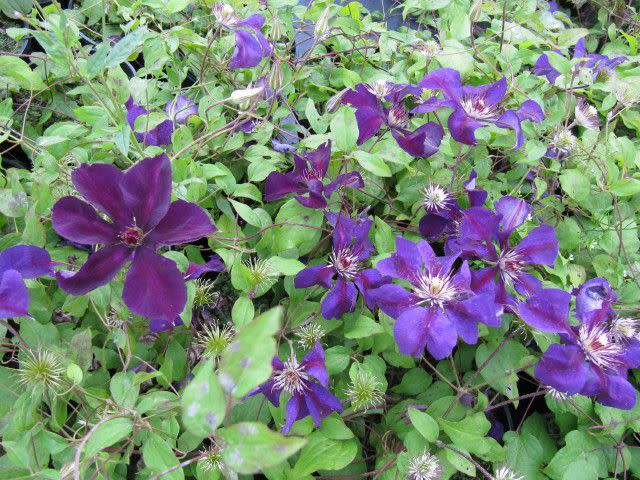
Leonora (Ellie) Enking / Flickr / CC BY-SA 2.0
First introduced in the late 19th century, Gipsy Queen is a vigorous grower and produces a wealth of six inch wide flowers in mid-summer to fall. Flowers are often red when they first emerge, but they quickly shift to a glorious shade of purple.
Plant Type: Perennial, deciduous vine
Size: 10 to 12 ft. long
Light: Partial shade
Growing Zone: 4 to 11
Will Goodwin
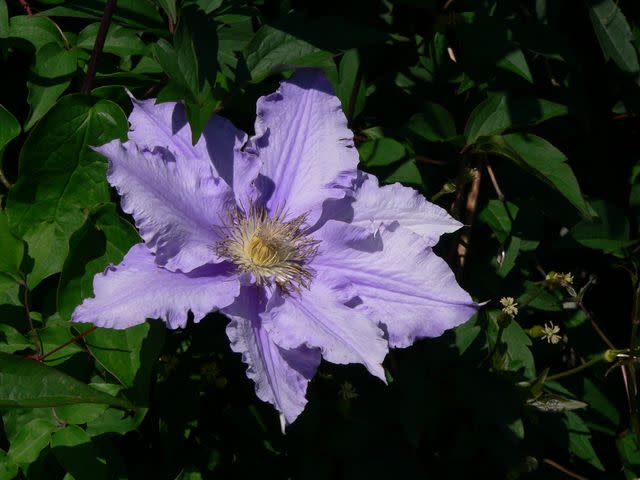
F. D. Richards / Flickr / CC BY-SA 2.0
A top choice for bouquets and floral arrangements, Will Goodwin’s blooms have an ethereal quality with ruffly, lavender-toned petals and golden yellow centers. While these plants are resistant to deer and rabbits, they’re bee-friendly and quite hardy.
Plant Type: Perennial, deciduous vine
Size: 10 to 12 ft. long
Light: Full sun to partial shade
Growing Zone: 4 to 9
Mrs. Yuki
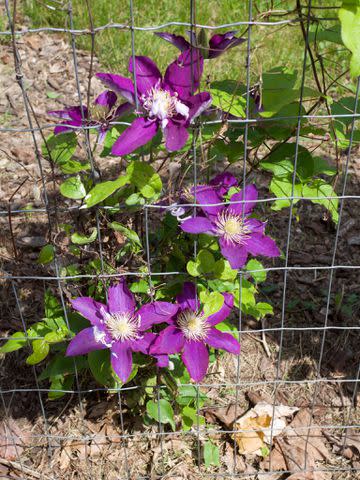
F. D. Richards / Flickr / CC BY-SA 2.0
Most clematis grow well in part shade, but Mrs. Yuki flowers best in full sun. These striking plants always draw the eye with their deep, reddish-purple petals and bright white, bulls-eye centers.
Plant Type: Perennial, deciduous vine
Size: 4 to 6 ft. long
Light: Full sun
Growing Zone: 4 to 11
Abilene
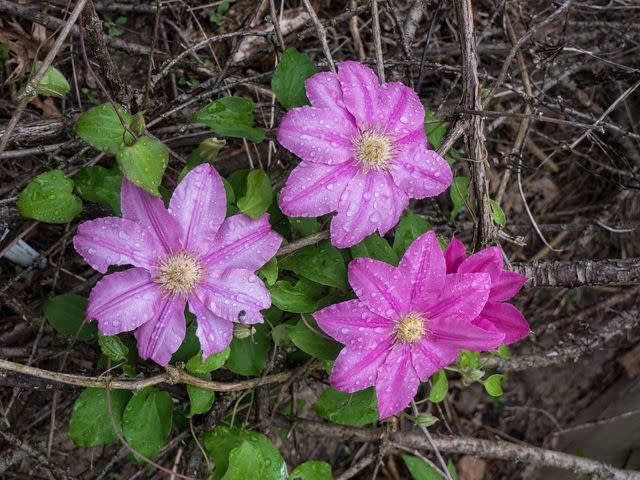
F. D. Richards / Flickr / CC BY-SA 2.0
If you want to add vertical interest to a patio or small space, Abilene is one of the best clematis varieties to try. These vining beauties have a compact growth habit and showy, two-toned flowers with lavender and bright pink coloration.
Plant Type: Perennial, deciduous vine
Size: 3 to 4 ft. long
Light: Full sun to partial shade
Growing Zone: 4 to 9
Julka
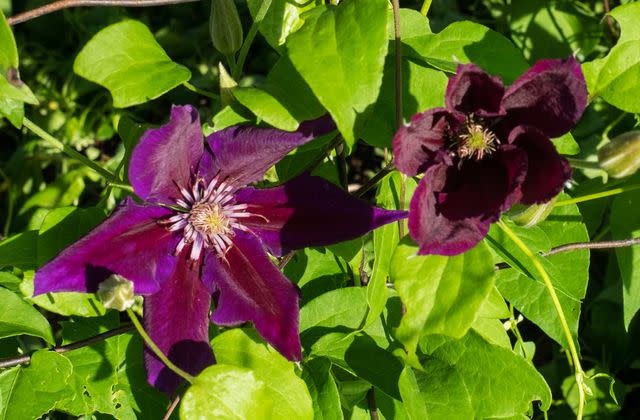
F. D. Richards / Flickr / CC BY-SA 2.0
Julka clematis brings the drama with velvety, purple-red flowers and bright green leaves. Vines happily twine around small trees and trellises, but they can also be used along garden borders or as accent plants in flower beds.
Plant Type: Perennial, deciduous vine
Size: 6 to 9 ft. long
Light: Full sun to partial shade
Growing Zone: 4 to 9
Frequently Asked Questions
What variety of clematis will bloom all summer?
Many popular clematis varieties bloom all summer, including ‘Alita,’ ‘Prince Charles,’ and ‘Sprinkles.’
Which type of clematis is easiest to grow?
Clematis types like ‘Alpine’ and ‘Anemone’ typically need minimal-to-no pruning, which can make them easier to care for. Clematis with small flowers are also more resistant to clematis wilt, and native clematis usually need less water than non-native varieties.
What is the most common clematis?
‘Anemone’ clematis are one of the most commonly grown clematis types due to their adaptability and low maintenance needs.
Read Next: 23 Types of Lavender Varieties for a Fragrant and Colorful Garden
Read the original article on The Spruce.

